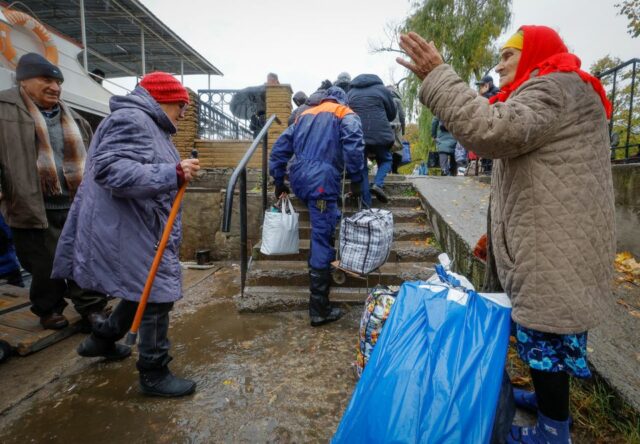
Ukraine’s Kherson and Zaporizhzhia Regions Under the Russian State of War (Part Two)
Publication: Eurasia Daily Monitor Volume: 19 Issue: 160
By:

*Click here to read Part One.
The Ukrainian army’s liberation campaign in Kherson region has ground to a halt. This should not be surprising as the army is insufficiently equipped with heavy long-range artillery, tanks and helicopters. Hopes that the Ukrainian army would advance and liberate Kherson mainly on the strength of their superior morale and leadership, as well as Russian deficiencies, have not been borne out. Ukrainian forces do not seem to have significantly advanced beyond the 500 square kilometers they held as of October 7 on the northern fringes of the 28,500-square-kilometer Kherson region (see EDM, October 12).
According to Ukrainian Defense Minister Oleksii Reznikov in interviews with international media, the offensive is stagnating because Russian troops are using the network of irrigation canals as trenches and because of autumn rains (Fox News, October 25, cited by Ukraiynska Pravda, October 26; and Japan Public TV, October 25, cited by Ukrinform, October 26). According to Deputy Defense Minister Anna Maliar on the national daily television newscast: “In Kherson region we find ourselves in an active defensive posture, the situation is under control, we are not losing territory” (Ukrinform, October 26).
The city of Kherson is the main prize of this campaign. According to the Ukrainian General Staff, the Russian army is building defensive positions around the city on both banks of the Dnipro River (Ukrinform, October 25). Ukraine’s military intelligence chief, General Kyrylo Budanov, told Ukrainian media that the Russian military is not about to withdraw from the city of Kherson onto the left bank of Dnipro as some had expected. Instead, the Russians are bringing troop reinforcements from the left bank into the city, preparing for defense and urban combat (Ukraiynska Pravda, October 24).
The civilian occupation authorities, however, continue the evacuation program they initiated in the second week of October in anticipation of a more successful Ukrainian offensive. The evacuation concept envisages resettling Kherson residents to Russia’s Rostov region, as well as Krasnodar and Stavropol territories. Residents from the right bank (in the path of potential Ukrainian military advances) are prioritized for evacuation, but left-bank residents are also entitled. In addition, the inclusion of children in this program has been emphasized. Evacuees are being offered accommodation in those regions gratis, as well as housing vouchers for those who choose to remain permanently there or in any Russian territory. Russian Deputy Prime Minister Marat Khusnullin is supervising this resettlement program from Moscow, coordinating with Kherson civilian occupation authorities. The program has been heavily publicized (TASS, October 13, 14, 18, 19, 21, 24).
The transparent intention is to send local Ukrainians into Russia’s interior for “Russification” and the resulting loss of national identity for adults and children. The city of Kherson is a Ukrainian-majority city. Its population of 328,000 at the latest census (2001) was, by ethnic self-identification, 77 percent Ukrainian and 20 percent Russian—and by native language, 53 percent Ukrainian and 45 percent Russian (the discrepancy reflects the legacy of forced Russification) (2001.ukrcensus.gov, accessed October 26). The ratio of ethnic and linguistic self-identification has, undoubtedly, changed in favor of Ukrainian since the 2001 census. Thus, the evacuation program is a move for “de-Ukrainization” and subsequent Russification.
The occupation authorities currently plan to resettle up to 60,000 Kherson city residents to Russia. The initial target number was higher but could not be met; the 60,000 figure also seems unlikely to be fulfilled without outright coercion. The authorities currently go door-to-door “recommending” the evacuation. Some 15,000 residents had crossed onto the left bank at last count, but few seem to have departed from Kherson region (TASS, October 23). Meanwhile, military-age men remaining in the city are being invited to volunteer for territorial defense detachments (RIA Novosti, October 24).
The civilian occupation administration has, however, largely evacuated itself from the right bank to the left bank of the Dnipro. From October 19 to date, the administration has relocated the Russian carpetbagger officials and most local collaborators, as well as archives, banks, internet providers and various other movable assets. Inter alia, they have evacuated the statues of Prince Grigory Potemkin (who lies buried in the city of Kherson), General Aleksandr Suvorov and Admiral Fedor Ushakov, figures emblematic of the Russian Empire’s conquest of Novorossiya in the late 18th century (RIA Novosti, October 24; TASS, October 26).
The civilian administration’s relocation is a precautionary measures as long as the Ukrainian army’s advance toward the city remains a possibility. That remains unlikely, however, unless Ukrainian forces are provided with the necessary military supplies and equipment by Western partners.



